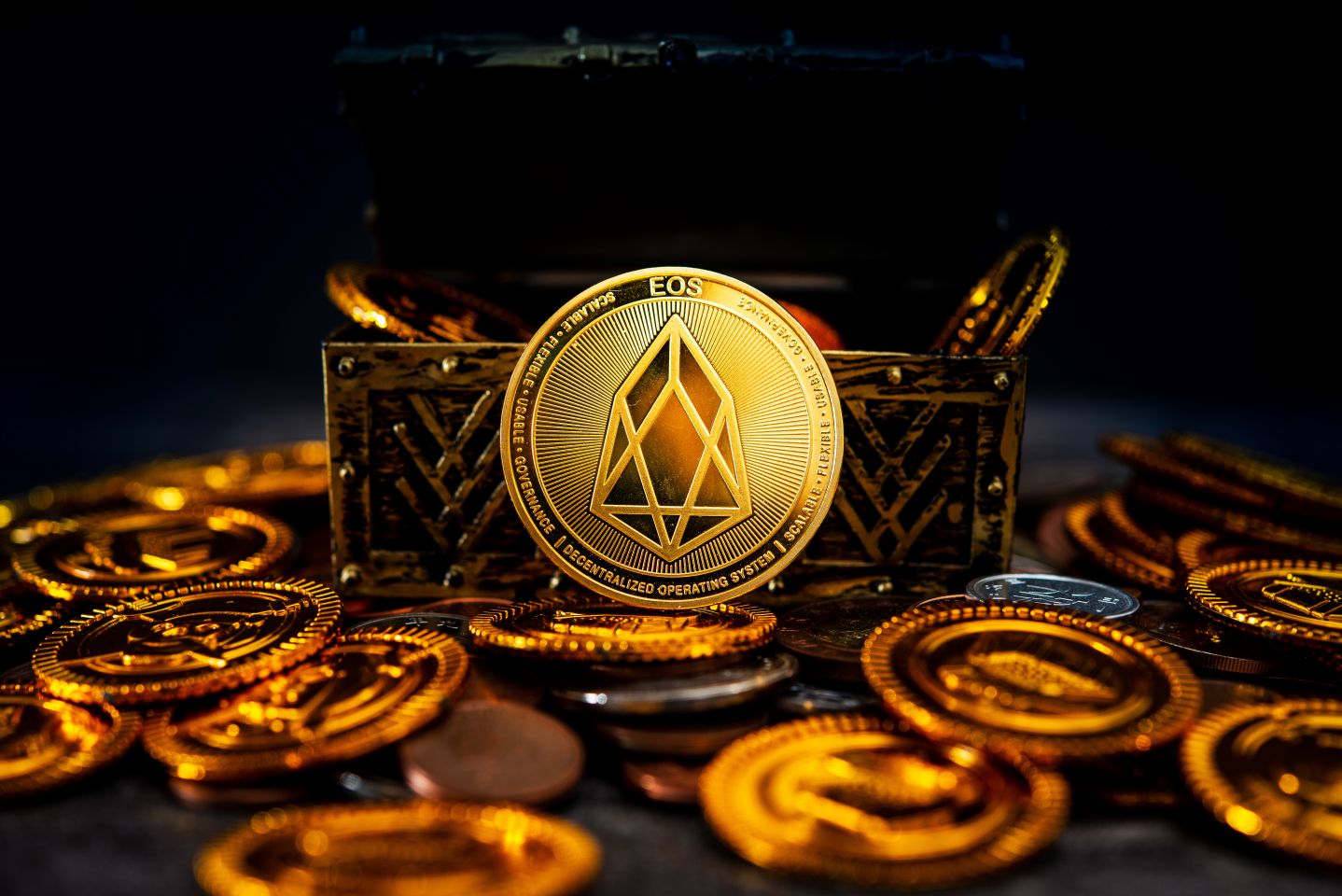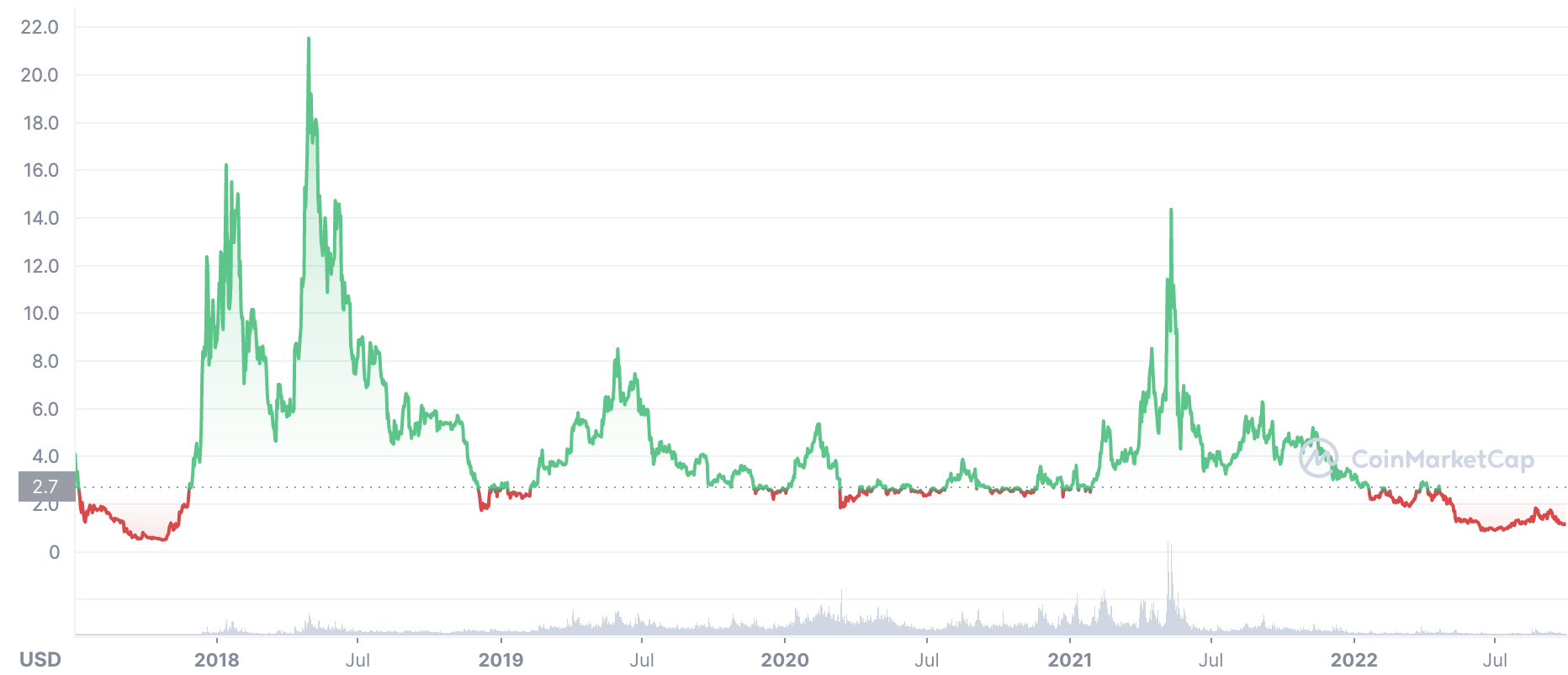EOS price prediction: Is EOS making a comeback?
EOS has had a volatile year, along with the rest of the crypto market
The coin of the EOSIO (EOS) blockchain has taken a sharp fall in 2022 after the EOS community launched its new Antelope protocol and a new yield product for investors.
But the EOS cryptocurrency struggled to live up to the hard-fork hype. As of 21 December 2022, it was trading at $0.889.
So what’s next for EOS? This article covers a fundamental and technical analysis, as well as a review of the project’s latest developments, to help you forecast a plausible EOS crypto price prediction.

What is the EOS coin?
EOSIO is a decentralised application (dApp) platform launched by blockchain company Block.one. It allows the development of decentralised applications that are secure, open and scalable.
EOSIO claims its fast transaction rates and sub-second block-time latency empower programmers to process transactions at a cheaper cost.
Additionally, EOSIO is designed to be configurable, useful for developing and maintaining programmable infrastructures. This allows developers to create public or private blockchain networks via the use of programmable smart contracts. According to the EOSIO whitepaper:
EOSIO distinguishes itself from other blockchains by enabling upgradeable smart contracts and being designed in C++. EOSIO currently supports two public blockchains, EOS and Telos, and over 400 applications, including Upland and Defibox.
Additionally, the EOSIO network powers the EOS Public Network, a delegated Proof-of-Stake-based system. EOS allows individuals and organisations to develop and use a diverse range of decentralised applications.
While EOSIO is a critical component of the EOS Public Network’s governance, it is not centralised. Instead, it is managed by a collaborative network of token holders.
The EOS coin is the network’s native token. Developers must own EOS tokens to access network resources and create and operate dApps. Token holders who do not run any applications can rent their bandwidth and earn staking rewards.

EOS community vs Block.One: The battle to control EOS
The split of the EOS community in December 2021 away from Block.one, the organisation that developed the project, has had little effect on the EOS coin price.
Trouble started when the EOS Network Foundation (ENF), the ‘rebels’, claimed Block.one was no longer acting in the network’s best interests. Then the top 25 EOS block producers elected to stop issuing 67 million (around $214m [£157m]) EOS vesting tokens scheduled to be unlocked and distributed to Block.one over the next seven or so years.
Yves La Rose, who heads up the ENF, said: “Over the course of the last year, we have seen a significant decline in the rate and quality of code production being output for EOSIO by Block.one.”
Things came to the boil when in November 2021 Block.one sold 45 million tokens to fund a purchase but the ENF argued that the “vesting tokens legally and rightfully belonged to the network”. An attempt at finding an agreement failed, which led to the block owners’ vote.
La Rose said: “There was no confiscation, no tokens in the Block.one account were taken, the account was not changed, keys were not modified. The network is no longer paying Block.one from the eosio.stake account, that is all.”
Deal reached
On 19 December 2021, it became clear a deal had been reached between the two parties with La Rose tweeting that the break between Block.one and the network was “clean”.
He added: “The EOS community doesn’t own its own codebase repo, nor does it own the IP of its own product base. Those are held in private and public entities that have their own respective shareholders. A rebrand is relatively simple and a means to start fresh.” In a later tweet he added: “The EOS community now sits as its own product lead.”
The development was keenly watched by the crypto community as it showed the first real test of what a decentralised community could do when it flexes its muscles.
On 17 February 2022, the EOS Network Foundation announced it was considering legal action against its parent Block.one, alleging that it “broke promises” to invest in the network and its failure to follow through affected network participants.
Although the exact value of the claim has yet to to be decided, the blockchain protocol did raise $4.1bn from network participants – so if any action goes ahead the eventual amount is likely to be significant. The announcement was made by Yves La Rose, CEO of the foundation, “to let the EOS community know we are aware of their concerns”.
Recent developments
While there is still uncertainty about the potential legal action from EOS’ community, Block.One has another lawsuit to contend with.
A class action lawsuit has been filed against the parent company for the EOS initial coin launch (ICO).
On 17 August 2022, the federal court rejected Block.One’s $27.5m settlement offer.
Meanwhile, the EOS community continues to push away from its troubled origins. La Rose announced in August that it was rebranding the EOSIO protocol to Antelope.
A hard fork then took place on the EOSIO blockchain on 21 September. This saw the protocol officially switch over to Antelope.
La Rose tweeted: “After a multi-year struggle for independence, the EOS community has proven that Web3 really does bring power back to the people. This is more than a hardfork. This is EOS Independence Day!”
Enjoying its status as a more decentralised protocol, EOS has recently launched a yield project for its users to earn higher rewards for staking the cryptocurrency.
La Rose tweeted: “Starting today, you can expect to see more opportunities to earn higher APY% for staking $EOS + $USDT. And because liquidity rewards are based on TVL, game-theory indicates that Yield+ will reduce the liquid supply of $EOS as more tokens are locked into smart contracts.”
EOS/USD price analysis
EOS traded in a bearish market in 2017 but gained momentum in the final months of the year. Its price fell from $4.08 on 3 July to $1.30 on 15 July. The price further collapsed to $0.53 on 28 October.
A strong bull rally pushed the EOS token price to $12.38 by 19 December, a rise of 2,235% from October’s bottom in less than two months. The prices bottomed at $7.84 on 22 December. It ended slightly higher at $8.76 as of 31 December 2017.
EOS price continued its bullish action in 2018 and reached $16.23 on 13 January 2018. However, bears eventually gained control, and the price collapsed to $4.65 on 18 March.
A strong leg of bull run lasted between March and April, and the EOS coin value reached the all-time high of $22.89 on 29 April. After making the top, EOS price continued to fall and reached $4.63 on 15 August. The price further collapsed to $1.74 on 7 December, a drop of more than 92% from the all-time high. It closed the year at $2.56 as of 31 December 2018.
EOS token traded in a slightly bullish market in 2019 and the price reached $8.51 on 31 May. However, the price continued to fall and bottomed to $2.20 on 17 December. It closed the year at $2.58 as of 31 December 2019, EOS coin chart showed.
Similarly, 2020 didn’t prove to be a remarkable year for the EOS token and price action turned bearish after it made a top of $5.36 on 14 February. The price bottomed at $1.84 on 12 March. It gained little momentum and reached $3.87 on 16 August. It closed the year at $2.59 as of 31 December 2020.
During the onset of 2021, bulls slightly gained control, and the price reached $5.49 on 13 February. Then, the price fell to $3.69 by 25 March before spiking again to $14.37 on 11 May. Eventually, the price bottomed to $3.26 on 20 July. It closed the year at $3.03 as of 31 December 2021.
Since the onset of 2022, price action has been bearish for the EOS token. January saw it fall below its launch price to a low of $2 that month.
It continued falling throughout this year, dropping below $2 in May and to a 52-week low of $0.8232 on 18 June.
EOS started rallying on the lead up to the Antelope hard fork. It climbed to a high of $1.86 on 10 September, a 126% rise from its low in June.
However, the cryptocurrency has struggled to live up to the hype post-hard fork. It plummeted to its 90-day low of $0.94 on 13 October.
As of 21 December 2022, EOS was trading at $0.8889 and was down 8.3% in the past seven days. However, it is still trading up 5..9% over the past 30 days, according to CoinMarketCap.
EOS/USD price chart, all-time performance

Source: CoinMarketCap
EOS price prediction: Targets for 2022, 2025, and 2030
Short-term EOS sentiment from CoinCodex was bearish, with 10 indicators giving a bullish signal and 19 signalling bearish signals, as of 21 December. However, short-term EOS price prediction by CoinCodex indicated the price could rise to $0.9952 by 26 December.
Meanwhile, several algorithm-based forecasting services shared moderately bullish long-term EOS crypto price predictions as of 6 December.
According to DigitalCoinPrice’s EOS price prediction for 2023, the cryptocurrency could average $2.12 next year and rise to $3.78 in 2025 and $12.40 in 2030.
Price Prediction believed the average price of EOS could hit $1.34 in 2023. Its EOS price prediction for 2030 gave an optimistic value of $19.45.
In its EOS coin price prediction, Wallet Investor called it a “bad” investment and predicted it could fall to $0.154 in a year. Its EOS price prediction for 2025 suggests it could close the year at $0.198.
When looking for EOS crypto predictions, bear in mind that analysts and algorithm-based predictions can be wrong. Their EOS projections are based on fundamental and technical studies of a cryptocurrency’s past performance. Past performance is no guarantee of future results.
It’s important to do your research and always remember your decision to trade depends on your attitude to risk, your expertise in the market, the spread of your investment portfolio and how comfortable you feel about losing money. You should never invest money that you cannot afford to lose.
FAQs
Is EOS a good investment?
Despite launching its new Antelope upgrade on 21 September, EOS was down more than 70% year-to-date (YTD), as of 21 December.
Whether the EOS token is a good fit for your investment portfolio depends on your expectations, circumstances and risk tolerance. So you should estimate the level of risk you are ready to take before investing. And never invest money that you cannot afford to lose.
Will EOS go up or down?
As of 21 December, EOS’s recent rally has led to some bullish forecasts, including from Price Prediction and DigitalCoinPrice. However, Wallet Investor expects EOS to eventually fall below $0.10.
In volatile cryptocurrency markets, it is important to do your own research on a coin or token to determine if it is a good fit for your investment portfolio. Whether EOS is a suitable investment for you depends on your risk tolerance and how much you intend to invest, among other factors. Keep in mind that past performance is no guarantee of future returns. And never invest money that you cannot afford to lose.
Should I invest in EOS?
After seperating from its parent company Block.One, EOS has recently launched a hard fork to a new upgrade. However, it has seen a bearish price history.
Whether you should invest in EOS is a question that you will have to answer for yourself. Before you do so, however, you will need to conduct your own research and never invest more money than you can afford to lose, because prices can go down as well as up.